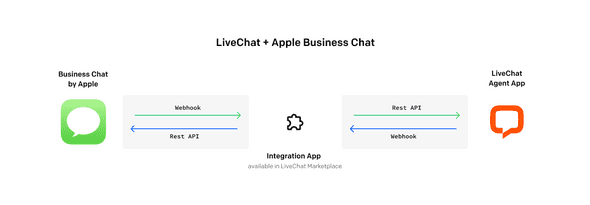The constantly growing variety of communication channels demands two primary things: filtering out key channels for your business and adopting them. In our case, integrating LiveChat with Business Chat by Apple was the filtrate. This is the story about how we approached that integration.
Business Chat by Apple is one of the newest communication channels on the market. It lets you reach out to companies straight from the Messages app on iPhones and iPads. This is the exact same way we connect with our friends: by texting them. Every conversation requires participation from both sides, and this is where LiveChat comes in.
Open Messaging APIs available
Integrating with external services like Apple Business Chat can be tricky. Fortunately, LiveChat provides a well-designed, flexible API that made the task straightforward. Several integration placements in the LiveChat Agent Application allowed for presenting the integration interface right where the agents expect it to be. Having those tools at our disposal, we decided to create this, and a few other communication channels, exactly the way any external developer would do it. We used our open API for the heavy lifting, integration places in the Agent App were the interface, and the Marketplace was the distribution platform.
The solution architecture
Communication is a two-way relationship. LiveChat understands this more than anyone, so the APIs are divided based on your role in the conversation. We have the Customer Chat API and Agent Chat API available for use. Since we wanted to create another communication channel for customers, we chose the API accordingly. Unfortunately, an external communication service will rarely be able to speak to LiveChat directly. You’ll need an application that translates one dialect into the other. This was also the case with Apple Business Chat.
This time, we went for Go. We like the language due to its simplicity and phenomenal out-of-the-box HTTP support. In most cases, its performance is the cherry on top. The integration itself sits between LiveChat’s and Apple’s services. Together, they make up all the parts we needed to implement.
Each of the parties messaging provides new messages, along with a couple of other events, using webhooks. The service needs to translate the messages into the format of the other provider and send it using the REST API. This is where the Go service shines. The built-in HTTP server for receiving webhooks and a great HTTP client for making the requests allowed us to create a robust and solid server in almost no time.
Native experience for agents and customers
Using the LiveChat Customer Chat API resulted in a truly native experience on the agent’s side. There wasn’t any difference between chats coming from the new channel and typical chats. This way, we avoided any possible difficulties in adopting new customers coming from this very channel. We just set up a new group, and our Support Team was ready to continue what they do every day: help customers.
Besides regular messaging, the Messages application offers some unique features related to the iOS platform. We wanted our agents to use them as tools for holding rich, engaging conversations with customers. Some of the features like Apple Pay or List picker allow for handling ecommerce services directly in the chat, which is extremely powerful. Choosing the right place for the interfaces was critical, and Agent App Widgets came to the rescue. The ready-to-use Agent App SDK and a simple iFrame interface allowed us to place the interface of those features on the righthand side of the Agent Application. As a result, there’s no need for agents to leave customers and the context of the conversation. What’s more, it provides a great, native experience for all iOS users.
Promotion and marketing strategies
Developing a great application is just the tip of an iceberg. Creating distribution channels, forming a marketing strategy, and providing support is equally challenging. Failing in any of these aspects could lead to disappointing results in terms of usage. Fortunately, we were able to profit from the variety of tools LiveChat provides. We used the LiveChat SEO-optimized Marketplace as the main distribution channel. Easy, one-click installation lowers any technical barriers customers might encounter using other applications.
The marketing tools provided by our Developer Program differ for each application. With numerous possibilities at hand, we can inform our customers via monthly newsletters, or take it a step further and display the app on the Agent App Dashboard. A broad range of marketing tools lets us adjust the promotion according to the target audience. Thanks to close cooperation with developers, we can decide that case by case.
What we’ve learnt
We managed to recreate the experience of an external developer, who uses the tools we provide, to build integrations with our product. Along the way, we identified the areas in our APIs and documentation that needed polishing. We addressed those issues to improve the usability and remove obstacles for future developers.
Most importantly, we validated our APIs are open and flexible enough to support even the biggest applications as new communication channels. There’s still room for creating other communication channes. If that’s what you’re considering, make sure to see our API documentation and reach out to us with questions at developers@livechat.com.
If you want to know more about building communication channels, see Connecting LiveChat with Cognigy.AI, where Cognigy.AI share their experience.
